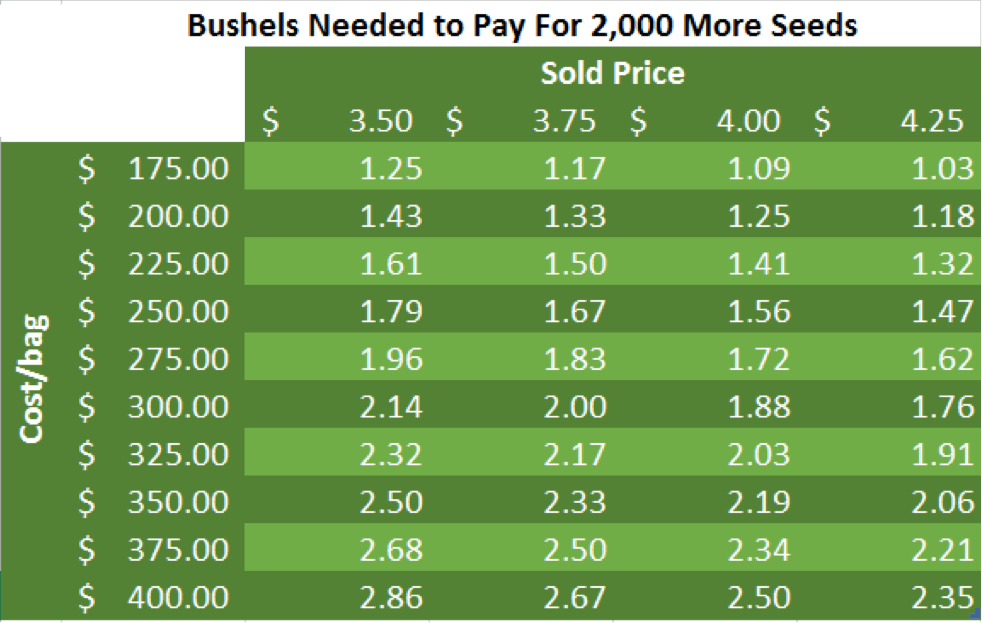Variable-rate Corn Won’t Save You Money

Variable-rate corn does however have the potential to make you money. Your financial investment is roughly the same with variable-rate corn as it is with flat rate. It’s where you put that investment that makes all the difference.
When you create a variable-rate corn prescription, the average number of plants per acre is usually within 1,000 seeds of the old flat-rate average. This is because you are removing excess plants from poor-performing areas and placing them in underpopulated, higher-performing areas where there is a good chance yield potential will be increased. I have found that seed costs can be reduced if a field has more below-average ground than above-average ground; however, this is a rare scenario.
The success of a variable-rate corn prescription depends on your individual goals. And, of course, every field is different. But how do you prove that a variable-rate prescription worked? Here is how I measure success.
Economics
Sometimes, it seems that when we spend money in agriculture, we expect a return that’s 10 times our investment. We need to realize that this may not always be the case, especially as we chase 300+ bushel-per-acre corn averages.
We need to make sure every investment made in our farm is beneficial for our bottom line. On the average prescription, we increase our population by 2,000 seeds when we move zones. So across a $175 to $400 per bag and $3.50 to $4.25 per bushel sold price, the average number of bushels we need to pay back our investment is roughly 2 bushels per acre.
Yield Potential Increase
Now that we know we need a minimum of 2 extra bushels when we increase population by 2,000 plants per acre to break even, we have to determine what constitutes a good response. This all comes back to hybrid placement. Through the Answer Plot® Program, we test multiple hybrids over different soil types, yield environments, crop management scenarios, populations, nitrogen levels, disease pressure and crop rotations. We cannot just say we want a 10-bushel-per-acre increase and anything less is unsatisfactory. We need to look at hybrid-specific and field-specific data. This allows us to determine a realistic yield goal per zone.
We can’t expect the same yield increase across low, medium and high yield environments. But by looking at how a product performs across different soil types and yield environments, we can optimize the performance of each product as well as each zone.
WinField provides a number of tools to help guide your decision making in creating optimal variable-rate corn prescriptions. For example, using Answer Plot® Program data through the Top 10 list and the Corn Characterization Chart (CHT Tool) within the R7® Tool can help you find products that fit your current management strategy, or show you what modifications to make to help ensure product success. Work with your WinField agronomist to take the steps needed to make variable-rate corn prescriptions work for your operation.
When you create a variable-rate corn prescription, the average number of plants per acre is usually within 1,000 seeds of the old flat-rate average. This is because you are removing excess plants from poor-performing areas and placing them in underpopulated, higher-performing areas where there is a good chance yield potential will be increased. I have found that seed costs can be reduced if a field has more below-average ground than above-average ground; however, this is a rare scenario.
The success of a variable-rate corn prescription depends on your individual goals. And, of course, every field is different. But how do you prove that a variable-rate prescription worked? Here is how I measure success.
Economics
Sometimes, it seems that when we spend money in agriculture, we expect a return that’s 10 times our investment. We need to realize that this may not always be the case, especially as we chase 300+ bushel-per-acre corn averages.
We need to make sure every investment made in our farm is beneficial for our bottom line. On the average prescription, we increase our population by 2,000 seeds when we move zones. So across a $175 to $400 per bag and $3.50 to $4.25 per bushel sold price, the average number of bushels we need to pay back our investment is roughly 2 bushels per acre.
Yield Potential Increase
Now that we know we need a minimum of 2 extra bushels when we increase population by 2,000 plants per acre to break even, we have to determine what constitutes a good response. This all comes back to hybrid placement. Through the Answer Plot® Program, we test multiple hybrids over different soil types, yield environments, crop management scenarios, populations, nitrogen levels, disease pressure and crop rotations. We cannot just say we want a 10-bushel-per-acre increase and anything less is unsatisfactory. We need to look at hybrid-specific and field-specific data. This allows us to determine a realistic yield goal per zone.
We can’t expect the same yield increase across low, medium and high yield environments. But by looking at how a product performs across different soil types and yield environments, we can optimize the performance of each product as well as each zone.
WinField provides a number of tools to help guide your decision making in creating optimal variable-rate corn prescriptions. For example, using Answer Plot® Program data through the Top 10 list and the Corn Characterization Chart (CHT Tool) within the R7® Tool can help you find products that fit your current management strategy, or show you what modifications to make to help ensure product success. Work with your WinField agronomist to take the steps needed to make variable-rate corn prescriptions work for your operation.


